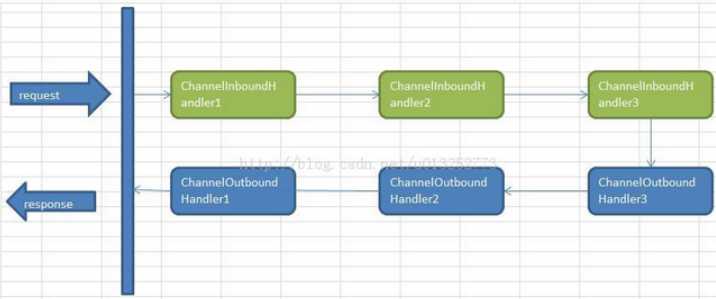标签:从服务器 void obj sock throwable ali size stack 处理程序
Handler在Netty中,无疑占据着非常重要的地位。Handler与Servlet中的filter很像,通过Handler可以完成通讯报文的解码编码、拦截指定的报文、
统一对日志错误进行处理、统一对请求进行计数、控制Handler执行与否。一句话,没有它做不到的只有你想不到的
Netty中的所有handler都实现自ChannelHandler接口。按照输入输出来分,分为ChannelInboundHandler、ChannelOutboundHandler两大类
ChannelInboundHandler对从客户端发往服务器的报文进行处理,一般用来执行解码、读取客户端数据、进行业务处理等;ChannelOutboundHandler
对从服务器发往客户端的报文进行处理,一般用来进行编码、发送报文到客户端
Netty中可以注册多个handler。ChannelInboundHandler按照注册的先后顺序执行;ChannelOutboundHandler按照注册的先后顺序逆序执行
如下图所示,按照注册的先后顺序对Handler进行排序,request进入Netty后的执行顺序为:

客户端代码同上
服务端代码及业务逻辑类:
import io.netty.bootstrap.ServerBootstrap; import io.netty.channel.Channel; import io.netty.channel.ChannelFuture; import io.netty.channel.ChannelInitializer; import io.netty.channel.EventLoopGroup; import io.netty.channel.nio.NioEventLoopGroup; import io.netty.channel.socket.nio.NioServerSocketChannel;/** * ? 配置服务器功能,如线程、端口 ? 实现服务器处理程序,它包含业务逻辑,决定当有一个请求连接或接收数据时该做什么 */ public class EchoServer { private final int port; public EchoServer(int port) { this.port = port; } public void start() throws Exception { EventLoopGroup eventLoopGroup = null; try { //server端引导类 ServerBootstrap serverBootstrap = new ServerBootstrap(); //连接池处理数据 eventLoopGroup = new NioEventLoopGroup(); serverBootstrap.group(eventLoopGroup) .channel(NioServerSocketChannel.class)//指定通道类型为NioServerSocketChannel,一种异步模式,OIO阻塞模式为OioServerSocketChannel .localAddress("localhost",port)//设置InetSocketAddress让服务器监听某个端口已等待客户端连接。 .childHandler(new ChannelInitializer<Channel>() {//设置childHandler执行所有的连接请求 @Override protected void initChannel(Channel ch) throws Exception { // 注册两个InboundHandler,执行顺序为注册顺序,所以应该是InboundHandler1 InboundHandler2 ch.pipeline().addLast(new EchoOutHandler1()); ch.pipeline().addLast(new EchoOutHandler2()); // 注册两个OutboundHandler,执行顺序为注册顺序的逆序,所以应该是OutboundHandler2 OutboundHandler1 ch.pipeline().addLast(new EchoInHandler1()); ch.pipeline().addLast(new EchoInHandler2()); } }); // 最后绑定服务器等待直到绑定完成,调用sync()方法会阻塞直到服务器完成绑定,然后服务器等待通道关闭,因为使用sync(),所以关闭操作也会被阻塞。 ChannelFuture channelFuture = serverBootstrap.bind().sync(); System.out.println("开始监听,端口为:" + channelFuture.channel().localAddress()); channelFuture.channel().closeFuture().sync(); } finally { eventLoopGroup.shutdownGracefully().sync(); } } public static void main(String[] args) throws Exception { new EchoServer(20000).start(); } }
业务类EchoInHandler1:
import io.netty.buffer.ByteBuf; import io.netty.buffer.Unpooled; import io.netty.channel.ChannelHandlerContext; import io.netty.channel.ChannelInboundHandlerAdapter; import java.util.Date; import cn.itcast_03_netty.sendobject.bean.Person; public class EchoInHandler1 extends ChannelInboundHandlerAdapter { @Override public void channelRead(ChannelHandlerContext ctx, Object msg) throws Exception { System.out.println("in1"); // 通知执行下一个InboundHandler ctx.fireChannelRead(msg);//ChannelInboundHandler之间的传递,通过调用 ctx.fireChannelRead(msg) 实现 } @Override public void channelReadComplete(ChannelHandlerContext ctx) throws Exception { ctx.flush();//刷新后才将数据发出到SocketChannel } @Override public void exceptionCaught(ChannelHandlerContext ctx, Throwable cause) throws Exception { cause.printStackTrace(); ctx.close(); } }
业务类 EchoInHandler2:
import io.netty.buffer.ByteBuf; import io.netty.buffer.Unpooled; import io.netty.channel.ChannelHandlerContext; import io.netty.channel.ChannelInboundHandlerAdapter; import java.util.Date; public class EchoInHandler2 extends ChannelInboundHandlerAdapter { @Override public void channelRead(ChannelHandlerContext ctx, Object msg) throws Exception { System.out.println("in2"); ByteBuf buf = (ByteBuf) msg; byte[] req = new byte[buf.readableBytes()]; buf.readBytes(req); String body = new String(req, "UTF-8"); System.out.println("接收客户端数据:" + body); //向客户端写数据 System.out.println("server向client发送数据"); String currentTime = new Date(System.currentTimeMillis()).toString(); ByteBuf resp = Unpooled.copiedBuffer(currentTime.getBytes()); ctx.write(resp); //用ctx.write(msg) 将传递到 ChannelOutboundHandler } @Override public void channelReadComplete(ChannelHandlerContext ctx) throws Exception { ctx.flush();//刷新后才将数据发出到SocketChannel } @Override public void exceptionCaught(ChannelHandlerContext ctx, Throwable cause) throws Exception { cause.printStackTrace(); ctx.close(); } }
业务逻辑类 EchoOutHandler2:
import io.netty.channel.ChannelHandlerContext; import io.netty.channel.ChannelOutboundHandlerAdapter; import io.netty.channel.ChannelPromise; public class EchoOutHandler2 extends ChannelOutboundHandlerAdapter { @Override public void write(ChannelHandlerContext ctx, Object msg, ChannelPromise promise) throws Exception { System.out.println("out2"); // 执行下一个OutboundHandler super.write(ctx, msg, promise); } }
业务逻辑类 EchoOutHandler1:
import java.util.Date; import io.netty.buffer.ByteBuf; import io.netty.buffer.Unpooled; import io.netty.channel.ChannelHandlerContext; import io.netty.channel.ChannelOutboundHandlerAdapter; import io.netty.channel.ChannelPromise; public class EchoOutHandler1 extends ChannelOutboundHandlerAdapter { @Override // 向client发送消息 public void write(ChannelHandlerContext ctx, Object msg, ChannelPromise promise) throws Exception { System.out.println("out1"); String currentTime = new Date(System.currentTimeMillis()).toString(); ByteBuf resp = Unpooled.copiedBuffer(currentTime.getBytes()); ctx.write(resp); ctx.flush(); //ctx.write()方法执行后,需要调用flush()方法才能令它立即执行 } }
运行结果:
开始监听,端口为:/127.0.0.1:20000
in1
in2
接收客户端数据:QUERY TIME ORDER
server向client发送数据
out2
out1
总结:
在使用Handler的过程中,需要注意:
1、ChannelInboundHandler之间的传递,通过调用 ctx.fireChannelRead(msg) 实现;调用ctx.write(msg) 将传递到ChannelOutboundHandler
2、ctx.write()方法执行后,需要调用flush()方法才能令它立即执行。
3、ChannelOutboundHandler 在注册的时候需要放在最后一个ChannelInboundHandler之前,否则将无法传递到ChannelOutboundHandler
(流水线pipeline中outhander不能放到最后,否则不生效)
4、Handler的消费处理放在最后一个处理。
标签:从服务器 void obj sock throwable ali size stack 处理程序
原文地址:https://www.cnblogs.com/yaboya/p/9176703.html